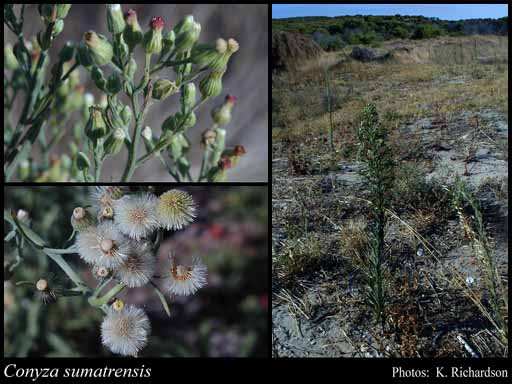This name is not current. Find out more information on related names.
- Reference
- J.Jap.Bot. 46:72 (1971)
- Conservation Code
- Not threatened
- Naturalised Status
- Alien to Western Australia
- Name Status
- Not Current
Annual, herb, to 2 m high. Fl. white/cream/yellow, Jan to Dec. Gritty loam, sandy clay, grey sand. Sand dunes, ditches, swamps, seasonally-wet sites, road verges.







Management Notes (for the Swan NRM Region)
Alternative Names. Broadleaf Fleabane, Guernsey Fleabane.
General Biology. Growth form. Herb. Life form. Annual. Reproduction. Seed. Dispersal. Wind. Toxicity. Suspected of poisoning stock, taints milk. Fire response. Killed by fire.
Notes. Widespread weed in warm temperate and subtropical regions, and widespread throughout Australia. Adapted to most soil types and prevalent in disturbed sites. Self-pollinated and cross pollinated. Has high and rapid seed production, high germination rates and dispersal capability. Light stimulates germination. Is a common contaminant of nursery plants. Has recorded herbicide resistance however no glyphosate-resistant Conyza populations have been recorded in Western Australia.
Additional information. Origin. Southern America, North America. Similar exotic species. Conyza bonariensis, C. parva.
Suggested method of management and control. Hand pulling of small and/or isolated infestations after stem elongation prior to seed set is effective on loose soils, but difficult on heavier soils. Mowing is ineffective. Most susceptible to glyphosate at early development of rosette stage. Apply 25 ml/ 10L glyphosate after stem elongation and before flowering in late spring to summer each year when the plants are actively growing. A mixture of 50% glyphosate can be used to wipe the stems of plants. Lontrel® 4 g/ 10 L (200 g/ha) + wetting agent can be spot sprayed for fairly selective control. Read the manufacturers' labels and material safety data sheets before using herbicides. For further information consult the Australian Pesticides and Veterinary Medicines Authority to determine the status of permits for your situation or state.
Management Calendar
| Calendar Type | Jan | Feb | Mar | Apr | May | Jun | Jul | Aug | Sep | Oct | Nov | Dec | Comments |
|---|---|---|---|---|---|---|---|---|---|---|---|---|---|
| Germination | O | Y | Y | Y | Y | Y | Y | O | |||||
| Active Growth | O | O | O | O | O | Y | Y | Y | Y | Y | Y | Y | |
| Flowering | Y | Y | Y | Y | Y | Y | Y | Y | Y | Y | Y | Y | |
| Fruiting | O | O | O | O | O | O | O | O | O | O | Y | Y | |
| Manual Removal | O | O | O | O | O | Y | Y | Y | Y | Y | O | O | |
| Herbicide Treatment | Y | Y | Y | Y | Y | Y |
Legend: Y = Yes, regularly, O = Occasionally, U = Uncertain, referred by others but not confirmed.
References
- Botanic Gardens Trust (Undated) Mount Annan Botanic Garden: *Conyza sumatrensis. Department of Environment, Climate Change and Water, Sydney, NSW. URL: http://www.rbgsyd.nsw.gov.au/science/Evolutionary_Ecology_Research/Ecology_of_Cumberland_Plain_Woodland/woodland_plants/conyza_albida - Accessed April 2010.
- Brown, K. & Brooks, K. (2002) Bushland Weeds: A Practical Guide to their Management. Environmental Weeds Action Network, Greenwood.
- Gonzlez-Torralva, F.,Cruz-Hipolito, H., Bastida, F., Mlleder, N., Smeda, R.J. & De Prado, R. (2010) Differential susceptibility to glyphosate among the Conyza weed species in Spain. Journal of Agricultural and Food Chemistry, 58 (7): 4361-4366.
- Hao, J., Qiang, S., Liu, Q. & Cao, F. (2009) Reproductive traits associated with invasiveness in Conyza sumatrensis. Journal of Systematics and Evolution, 47 (3): 245-254.
- Hussey, B.M.J., Keighery, G.J., Dodd, J., Lloyd, S.G. & Cousens, R.D. (2007) Western Weeds. A guide to the weeds of Western Australia. 2nd Edition. The Plant Protection Society of Western Australia, Victoria Park.
- Moore, C.B. & Moore, J.H. (2002) Herbiguide, the pesticide expert on a disk. Herbiguide, PO Box 44 Albany, Western Australia, 6330.
- Owen, M.J. (2009) A survey in the southern grain belt of Western Australia did not find Conyza spp. resistant to glyphosate. Weed Technology, 23 (3): 492-494.
- Thebaud, C., Finzi, A.C., Affre, L., Debussche, M. & Escarre, J. (1996) Assessing why two introduced Conyza differ in their ability to invade Mediterranean old fields. Ecology, 77 (3): 791-804.
- USDA, ARS, National Genetic Resources Program (2009) Germplasm Resources Information Network - (GRIN). National Germplasm Resources Laboratory, Beltsville, Maryland. URL: https://npgsweb.ars-grin.gov/gringlobal/taxon/taxonomysimple.aspx - Accessed October 2009.
- Weaver, S.E. (2001) The biology of Canadian Weeds. 115. Conyza canadinensis. Canadian Journal of Plant Science, 81 (4): 867-873.
- Wilken, D. & Hannah, L. (1998) Conyza bonariensis (L.) Cronquist (Asteraceae). Flax leafed fleabane..
- Wu, H. (2007) The biology of Australian weeds 49. Conyza bonariensis (L.) Cronquist. Plant Protection Quarterly, 22 (4): 122-131.